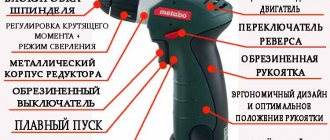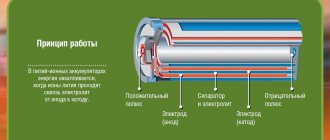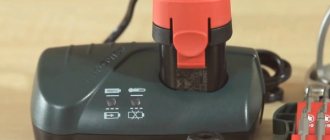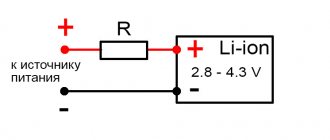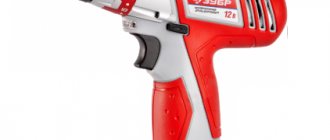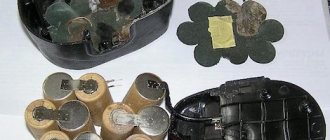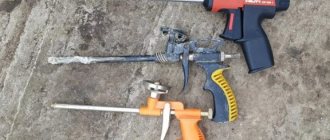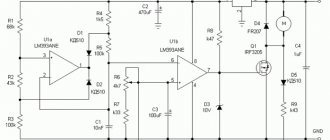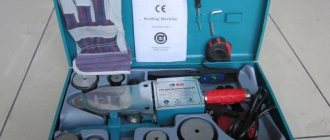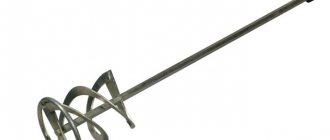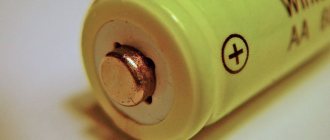Types of batteries by type of materials used
Which batteries are best for a screwdriver are usually indicated in the instructions for this tool. The battery type is indicated in Latin letters. Most often, high-current 18650 batteries are used for screwdrivers. However, there are other options.
Such devices are produced by a variety of brands. The most famous include Bosch (Bosch), Hitachi, Zubr, Interskol, Metabo. It is also possible to order a battery on Aliexpress in China. However, it is better to give preference to trusted manufacturers.
Nickel-cadmium
This type of battery appeared in the middle of the last century. They use nickel oxide hydrate as a cathode, which complements graphite powder. An electrolyte is used to move the ions. Potassium hydroxide is used in its role. It also contains an anode made from cadmium oxide hydrate.
Nickel metal hydride
This material is most often used in AA batteries. It was invented in the seventies of the last century. Nickel oxide and nickel-lanthanum are used as the main elements for accumulating and transferring charge. The first component is the cathode, the second is the anode. Potassium hydroxide is responsible for the movement of ions.
Lithium-ion batteries
These are relatively new batteries that were invented only in 1991. They are often used by Japanese companies. The cathode and anode are made of foil. A separator is installed between these elements, which has holes. A valve is used to relieve internal pressure.
Lithium polymer battery
This is a modern material that is based on the use of lithium-ion technology. Therefore, it is almost never used for the production of electrical equipment. Instead of a standard electrolyte, such devices use a gel polymer. Thanks to this, manufacturers were able to significantly increase capacity. In addition, they can give the battery any shape.
Note! If you need to buy an affordable and long-lasting battery, a nickel-cadmium model is suitable. If you need a high volume of capacitive charge, you should use lithium-based products.
There are different types of battery materials
Ni-Cd (nickel-cadmium)
Batteries of this type are real long-lived, in every sense. Despite the fact that they were invented back in 1899, in terms of their performance characteristics they leave far behind all the latest developments in this area. The only thing they cannot “argue” about is the large weight and dimensions, the presence of a strong memory effect, although it practically disappears with subsequent regular full discharges.
Photo: www.toool.ru Makita 193981-6 Ni-Cd battery
The phenomenon in which a battery loses its capacity available for charging due to the fact that it was not completely discharged during operation is called the memory effect. The physics of the process is similar to filling a glass with water. A clean, empty glass holds a certain amount of liquid. This volume is always larger than what would fit in the same container, but, for example, filled with pebbles. So, if the battery is not sufficiently discharged, the active substance changes its structure during the charging process, its particles become larger and can no longer perform their functions.
But the main problem, which by and large became the reason for the active implementation of lithium-ion technology by manufacturers of electrical equipment, was the toxicity of cadmium and the need for its proper disposal, which is quite expensive for them. But in all other respects, Ni-Cd is unrivaled, because only it can work effectively if
- unpretentiousness and reliability are needed,
- I want to buy a battery that will last at least 6-7 years, withstand 1000-1500 charge-discharge cycles with a probability of capacity recovery of 70-80%,
- It is important that the battery can be stored for a long time,
- operation requires large charging currents,
- it is expected to work in difficult conditions for operating electrical equipment,
- you need to work at sub-zero temperatures (temperatures from -40 to +60 ˚С are acceptable),
- the ability to maintain stable voltage throughout the entire operating cycle is important,
- operation requires a maximum speed of full charge (on average 1 hour).
All this makes Ni-Cd indispensable when completing high-power hand-held power tools.
Battery types
Today there are quite a few effective batteries that can be used in screwdrivers. However, they all have certain pros and cons. So, how to choose a battery for a screwdriver?
Nickel-cadmium and nickel-metal hydride batteries
Many people are interested in which battery is better, li-ion or ni-cd for a screwdriver. To choose, you need to understand their pros and cons.
Nickel-cadmium products belong to the alkaline category. They provide stable power and do not heat up.
The main disadvantage of the products is the high toxicity of cadmium. In addition, they have a pronounced memory effect. Therefore, the products have to be charged after being completely discharged. The advantages of the models include stable operation even in cold weather, fast charging, and light weight.
Nickel metal hydride (Ni-MH) products appeared a little later. They do not involve the use of toxic cadmium. At the same time, the main disadvantages of the products include heating of the components, a small temperature range, and loss of capacity upon complete discharge.
Lithium-ion batteries and their benefits
These batteries are considered a new development. They are not alkaline elements and are rapidly displacing Ni-Cd and Ni-MH from the market.
The advantages of such products include the following:
- no memory effect;
- high capacity;
- low self-discharge parameters;
- fast charging;
- high fire safety indicators;
- high energy intensity.
At the same time, the disadvantages of such products include high price, the need to ensure certain storage conditions, and limited service life. You also have to have special chargers depending on the type of battery.
Lithium-ion batteries have many advantages
Differences in batteries according to basic technical characteristics
Rechargeable batteries, like any electrical element, have basic technical indicators according to which you can evaluate the merits of a particular type. Let's look at some characteristics
Operating and discharge voltage
The operating voltage value for batteries is a constant indicator and can only change slightly as the charge decreases during operation. Nicd or nimh batteries have the same nominal voltage of 1.2 V, as well as a discharge reading of 0.9 V. For lithium, such readings differ significantly as a result of the use of active elements in their composition. The operating voltage is 3.6 V, with a discharge of 3 V.
Operating temperature range
Operating temperature is an important indicator during battery operation. It is not always possible to use electrical equipment indoors and in the summer. For nickel batteries, the temperature range is quite wide, this is due to the fact that an alkaline composition with a low freezing value of -50°C is used as the electrolyte. For a lithium battery this figure is slightly higher from -20°C.
The value of the high temperature limit for all types is almost the same and is +50°C, +60°C.
Means of protection and control
Ni mh and li ion batteries have special protective components in their design. During the production process, temperature and pressure sensors are installed, as well as safety valves.
Attention! During the charging process, it is necessary to correctly set the parameters and also control them.
Storage
Storage conditions for various batteries:
- nickel-cadmium batteries can be stored when fully discharged, and immediately restore their characteristics when the charge is replenished;
- It is not recommended to completely discharge nickel metal hydride batteries;
- lithium batteries have a limited service life, therefore manufacturers recommend active use; if storage is required, the battery is discharged by half.
Comparison of batteries used for screwdrivers
How to choose a battery for a screwdriver? To do this, you need to take into account a number of important parameters.
Number of charge and discharge cycles
In devices with Ni-Cd batteries, this parameter reaches 1000 cycles. That is why they occupy a leading position in this indicator. In this case, Li-Ion batteries can be charged and discharged 600 times, after which they need to be replaced.
Fast charging ability
For large-scale work, craftsmen often use 2 batteries. In such a situation, charging speed matters. For nickel-cadmium and nickel-metal hydride batteries, this parameter is 4-8 hours. In this case, lithium-ion batteries can be charged from half an hour to 2 hours.
For reference! Popular European and Japanese manufacturers add a second battery to the device. In this case, the user can work almost without interruption.
Price
Nickel-cadmium batteries have the most affordable price. In second place are nickel-metal hydride batteries. Li-Ion products are considered the most expensive. Sometimes their price is half the cost of the screwdriver itself.
Response to tool operation at full power
If you need to make a hole in a hard surface, the full power of the screwdriver is required. In such a situation, it begins to actively consume charge. Ni-Cd and Ni-Mh are considered the most powerful. If you need maximum energy output, you should give preference to them.
Charge level memory effect
If the battery is not completely discharged and is put on charge, the remaining indicators are perceived by it as 0. This condition is called the memory effect. It is typical for all batteries that contain nickel. However, lithium-ion models do not have this drawback.
Self-discharge
Sometimes there is a situation in which a screwdriver was not used, and then suddenly needed. In this case, it may turn out that the battery has discharged itself and needs to be charged. This option is considered not very convenient. This situation is typical for nickel-cadmium and nickel-metal hydride batteries. In the first case, the self-discharge rate is 10%, in the second - 7-10% per month. For lithium-ion batteries it does not exceed 3-5%.
Batteries need to be charged on time
Dimensions
The batteries are attached to the screwdriver handle. Their size determines the weight of the power tool and the comfort of its use. This is relevant when working for a long time. Nickel-based batteries are considered the heaviest.
Note! Lithium-ion devices are smaller in size. They are made in the form of a clip, which takes up space in the tool handle and has no extension.
Working in the cold
Most often, this power tool is used inside buildings. But from time to time it has to be used in the fresh air or in rooms without heating. In this case, you need to know that lithium-ion models do not withstand negative temperatures well. They quickly discharge or fail completely.
Therefore, in such conditions it is recommended to give preference to batteries with nickel. They hold a charge well and can function even at temperatures of -20 degrees.
Attitude towards full discharge
This parameter affects the duration of use of the device. Lithium-ion batteries must not be completely discharged. The ideal storage option is considered to be 40% charge. Nickel batteries can be used until the power tool stops rotating completely.
Estimated service life
The duration of use is affected by the frequency and correctness of use. Lithium-ion batteries last the longest.
The best batteries for a screwdriver
The rating of the best high-current 18650 batteries for a screwdriver will help you choose a battery suitable for your tool among a variety of models.
Battery Li-Ion 2500 mAh SAMSUNG INR18650-25R 1 pc
This model is the first among the best 18650 for a screwdriver. The battery without protection ensures stable operation and high discharge current with small dimensions. Universal lithium-ion battery for all devices. The part is sensitive to overheating (the use of a soldering iron is prohibited; instead, it is advisable to use welded contact pads). Supplied in cardboard packaging.
current strength - up to 20 amperes;
voltage - 3.7 volts;
number of charge cycles - 600;
capacity - 2.5 Ah.
Prices in online stores
Battery 18650 Samsung INR18650-25S, 2500mAh 35A
High-current lithium-ion battery for use in professional screwdrivers and other electronics. Battery without protection. It is recommended to use contact pads for installation instead of a soldering iron. The battery can withstand temperatures from -20 to 80 degrees during operation and up to 50 degrees when charging.
current strength - up to 35 amperes;
voltage - 3.6 volts;
number of charge cycles - 250;
capacity - 2.5 Ah;
weight - 47 g.
Prices in online stores
Battery Li-ion SONY US 18650 VTC5 2600 mAh 30 A 3.7V
Sony's latest generation lithium-ion battery for household screwdrivers. The battery is universal, without protection. It is possible to operate with high current strength with small dimensions. Permissible temperature during operation is from -20 to 60 degrees ; when charging - up to 40 degrees . After 500 recharges, the capacity can be reduced to 80% of the nominal.
current strength - up to 30 amperes;
voltage - 3.7 volts;
number of charge cycles - 500;
capacity - 2.6 Ah;
weight - 53 g.
Prices in online stores
Battery Li-ion SONY US 18650 VTC5A 2600 mAh 35 A 3.7V (1 pc.)
High power battery without protection. The battery is suitable for all types of equipment, including screwdrivers. After a certain number of recharges, the battery’s performance is maintained, but the capacity can be reduced by 20%. Storage at temperatures up to 45 degrees . The permissible temperature during operation is up to 80 degrees Celsius .
current strength - up to 35 amperes;
voltage - 3.7 volts;
number of charge cycles - 500;
capacity - 2.6 Ah;
weight - 50 g.
Prices in online stores
Battery Li-ion SONY US 18650 VTC6 3000 mAh 30 A 3.7V (1 pc.)
High current VTC6 . An ideal option for assembling battery packs intended for subsequent autonomous power supply of various types of equipment, including screwdrivers.
current strength - up to 30 amperes;
voltage - 3.7 volts;
number of charge cycles - 500;
capacity - 3 Ah;
weight - 45 g.
Prices in online stores
Battery LiitoKala 18650 Li-ion 3.7V 3400mAh unprotected (NCR18650B) 5 pcs.
A set of universal batteries from a Chinese brand. No protective boards are provided, so the parts are suitable for assembling batteries for screwdrivers. The batteries are made of nickel and cobalt, but the memory effect is very low. Failure is possible at a voltage of 2.5 V.
voltage - 3.7 volts;
number of charge cycles - 1000;
capacity - 3.4 Ah;
weight - 48 g.
Prices in online stores
Battery LiitoKala HG2 18650 Li-ion 3.7V 3000mAh unprotected 5 pcs
A set of universal lithium-ion batteries. A low percentage of self-discharge and the absence of a protective board are the main advantages for choosing these batteries for the purpose of assembling batteries for screwdrivers. At a voltage of 2.5 V and below, the battery fails.
current strength - up to 30 amperes;
voltage - 3.7 volts;
number of charge cycles - 1000;
capacity - 3 Ah;
weight - 48 g.
Prices in online stores
18650 3350mAh Panasonic NCR18650B 3.6V unprotected Li-Ion battery
Powerful universal battery for various types of equipment, including household and professional screwdrivers. Special nickel clips are welded to the platforms to facilitate the assembly of battery packs. At a voltage of 2.5 V, damage is possible.
current strength - up to 30 amperes;
voltage - 4.78 volts;
number of charge cycles - 500;
capacity - 3350 mAh;
weight - 50 g.
Prices in online stores
What to look for when buying a cordless screwdriver
To purchase a quality device, it is recommended to take into account a number of important parameters.
What does battery capacity mean?
This indicator is designated by numbers 1-7 and is estimated in amperes. Since the tool requires 1-5A per hour, it can be used for 2-8 hours.
When purchasing, you need to consider the capacity
What does battery voltage mean?
The maximum voltage setting for screwdrivers is 36 V. They are suitable for working on durable materials. Indicators of 3-10 V are typical for low-power devices. They can only be used for small fasteners or soft materials.
Li-pol (lithium polymer)
This is the latest development based on lithium-ion technology. The difference between them is that the liquid electrolyte is replaced by a gel-like polymer. As a result, the manufacturer was able to increase the battery capacity and remove any restrictions on the shape of the battery case, including ultra-thin elements. In addition, their advantage in relation to lithium-ion batteries can be considered a lower risk of explosion.
Photo: hackaday.com
Obvious disadvantages in addition to those that occur with Li-ion batteries are
- service life – 2 years from the date of production,
- 300-500 cycles,
- high demands on compliance with operating conditions.
Li-pol is still rarely used as a battery for power tools, but judging by the active implementation of their predecessors, this process is limited only by their cost. It is the high price that prevents lithium technology from completely overcoming Ni-Cd, although even in this case, for working with powerful tools in difficult conditions, Li-ion and Li-pol technologies will still not replace them.
What do Li-Ion and Ni-Cd batteries have in common?
The forms and some parameters of these classes of batteries are determined by GOST 26692-85. In particular. This standard establishes for both types:
- Dimensions.
- Acceptance and testing procedure.
- Conditions for safe use.
- Completeness of delivery.
- Labeling, packaging and transportation to consumers.
- List of instructions for safe operation.
- Manufacturer's warranty.
Important! Since the areas of application of batteries of this type are constantly expanding, GOST R IEC 61426-1-2014 has recently been introduced and applied, which stipulates the general requirements for batteries used as renewable energy sources (for example, in photovoltaics).
Ni-Cd 1.2v
The battery capacity ranges are also common: both can be produced with values from 1.2 to 3.6 Ah or more. A common property is the efficiency of charge/discharge cycles, which, depending on the specific manufacturer, ranges from 70...90%.
